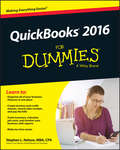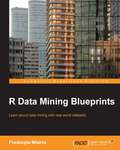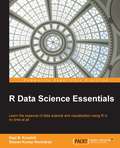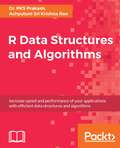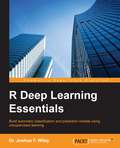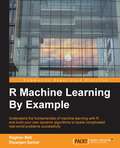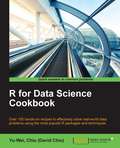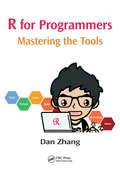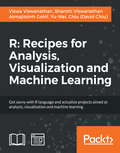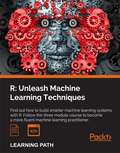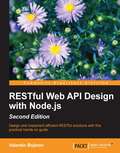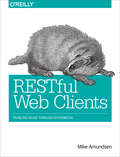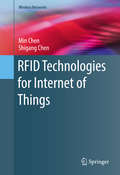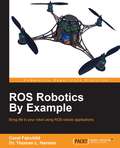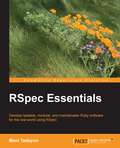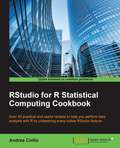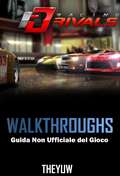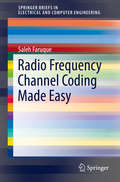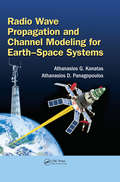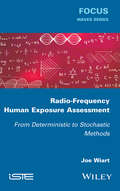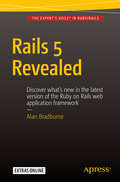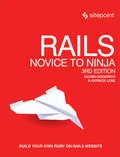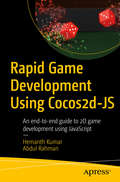- Table View
- List View
QuickBooks 2016 For Dummies
by Stephen L. NelsonThe perennial bestseller on QuickBooks—now covering QuickBooks 2016 If you're like most people involved with a small business, accounting is the last thing you want to spend a lot of time on. Luckily, QuickBooks 2016 For Dummies makes it easy to keep your finances under control so you can concentrate on other aspects of your business. In no time, you'll find out how to populate QuickBooks lists, create invoices and credit memos, record a sales receipt, track sales and inventory, pay bills, process payroll, track business checkbooks and credit cards, and so much more. QuickBooks is the leading small business accounting software package designed to help users handle their financial and business management tasks more effectively. With plain-English explanations that cut through financial jargon, this easy-to-follow guide walks you through installing the software and configuring QuickBooks for your business needs and goes on to show you how to build the perfect budget, simplify tax return preparation, and generate financial reports—without ever breaking a sweat! Organize all of your business finances in one place Create invoices and credit memos, record sales receipts, and pay the bills Track inventory, figure job costs, and monitor your business with reports Make tax time easier Written by an expert CPA who knows QuickBooks and understands your unique business needs, QuickBooks 2016 For Dummies is your go-to guide for getting past the paperwork and putting the program to work.
R Data Mining Blueprints
by Pradeepta MishraLearn about data mining with real-world datasets About This Book * Diverse real-world datasets to teach data mining techniques * Practical and focused on real-world data mining cases, this book covers concepts such as spatial data mining, text mining, social media mining, and web mining * Real-world case studies illustrate various data mining techniques, taking you from novice to intermediate Who This Book Is For Data analysts from beginner to intermediate level who need a step-by-step helping hand in developing complex data mining projects are the ideal audience for this book. They should have prior knowledge of basic statistics and little bit of programming language experience in any tool or platform. What You Will Learn * Make use of statistics and programming to learn data mining concepts and its applications * Use R Programming to apply statistical models on data * Create predictive models to be applied for performing classification, prediction and recommendation * Use of various libraries available on R CRAN (comprehensive R archives network) in data mining * Apply data management steps in handling large datasets * Learn various data visualization libraries available in R for representing data * Implement various dimension reduction techniques to handle large datasets * Acquire knowledge about neural network concept drawn from computer science and its applications in data mining In Detail The R language is a powerful open source functional programming language. At its core, R is a statistical programming language that provides impressive tools for data mining and analysis. It enables you to create high-level graphics and offers an interface to other languages. This means R is best suited to produce data and visual analytics through customization scripts and commands, instead of the typical statistical tools that provide tick boxes and drop-down menus for users. This book explores data mining techniques and shows you how to apply different mining concepts to various statistical and data applications in a wide range of fields. We will teach you about R and its application to data mining, and give you relevant and useful information you can use to develop and improve your applications. It will help you complete complex data mining cases and guide you through handling issues you might encounter during projects. Style and approach This fast-paced guide will help you solve predictive modeling problems using the most popular data mining algorithms through simple, practical cases.
R Data Science Essentials
by Sharan Kumar Ravindran Raja B. KoushikLearn the essence of data science and visualization using R in no time at allAbout This BookBecome a pro at making stunning visualizations and dashboards quickly and without hassleFor better decision making in business, apply the R programming language with the help of useful statistical techniques.From seasoned authors comes a book that offers you a plethora of fast-paced techniques to detect and analyze data patternsWho This Book Is ForIf you are an aspiring data scientist or analyst who has a basic understanding of data science and has basic hands-on experience in R or any other analytics tool, then R Data Science Essentials is the book for you.What You Will LearnPerform data preprocessing and basic operations on dataImplement visual and non-visual implementation data exploration techniquesMine patterns from data using affinity and sequential analysisUse different clustering algorithms and visualize themImplement logistic and linear regression and find out how to evaluate and improve the performance of an algorithmExtract patterns through visualization and build a forecasting algorithmBuild a recommendation engine using different collaborative filtering algorithmsMake a stunning visualization and dashboard using ggplot and R shinyIn DetailWith organizations increasingly embedding data science across their enterprise and with management becoming more data-driven it is an urgent requirement for analysts and managers to understand the key concept of data science. The data science concepts discussed in this book will help you make key decisions and solve the complex problems you will inevitably face in this new world.R Data Science Essentials will introduce you to various important concepts in the field of data science using R. We start by reading data from multiple sources, then move on to processing the data, extracting hidden patterns, building predictive and forecasting models, building a recommendation engine, and communicating to the user through stunning visualizations and dashboards.By the end of this book, you will have an understanding of some very important techniques in data science, be able to implement them using R, understand and interpret the outcomes, and know how they helps businesses make a decision.Style and approachThis easy-to-follow guide contains hands-on examples of the concepts of data science using R.
R Data Structures and Algorithms
by Achyutuni Sri Rao Dr Pks PrakashIncrease speed and performance of your applications with efficient data structures and algorithms About This Book * See how to use data structures such as arrays, stacks, trees, lists, and graphs through real-world examples * Find out about important and advanced data structures such as searching and sorting algorithms * Understand important concepts such as big-o notation, dynamic programming, and functional data structured Who This Book Is For This book is for R developers who want to use data structures efficiently. Basic knowledge of R is expected. What You Will Learn * Understand the rationality behind data structures and algorithms * Understand computation evaluation of a program featuring asymptotic and empirical algorithm analysis * Get to know the fundamentals of arrays and linked-based data structures * Analyze types of sorting algorithms * Search algorithms along with hashing * Understand linear and tree-based indexing * Be able to implement a graph including topological sort, shortest path problem, and Prim's algorithm * Understand dynamic programming (Knapsack) and randomized algorithms In Detail In this book, we cover not only classical data structures, but also functional data structures. We begin by answering the fundamental question: why data structures? We then move on to cover the relationship between data structures and algorithms, followed by an analysis and evaluation of algorithms. We introduce the fundamentals of data structures, such as lists, stacks, queues, and dictionaries, using real-world examples. We also cover topics such as indexing, sorting, and searching in depth. Later on, you will be exposed to advanced topics such as graph data structures, dynamic programming, and randomized algorithms. You will come to appreciate the intricacies of high performance and scalable programming using R. We also cover special R data structures such as vectors, data frames, and atomic vectors. With this easy-to-read book, you will be able to understand the power of linked lists, double linked lists, and circular linked lists. We will also explore the application of binary search and will go in depth into sorting algorithms such as bubble sort, selection sort, insertion sort, and merge sort. Style and approach This easy-to-read book with its fast-paced nature will improve the productivity of an R programmer and improve the performance of R applications. It is packed with real-world examples.
R Deep Learning Essentials
by Dr Joshua WileyThis book caters to aspiring data scientists who are well versed with machine learning concepts with R and are looking to explore the deep learning paradigm using the packages available in R. You should have a fundamental understanding of the R language and be comfortable with statistical algorithms and machine learning techniques, but you do not need to be well versed with deep learning concepts.
R Machine Learning By Example
by Raghav Bali Dipanjan SarkarUnderstand the fundamentals of machine learning with R and build your own dynamic algorithms to tackle complicated real-world problems successfully About This Book * Get to grips with the concepts of machine learning through exciting real-world examples * Visualize and solve complex problems by using power-packed R constructs and its robust packages for machine learning * Learn to build your own machine learning system with this example-based practical guide Who This Book Is For If you are interested in mining useful information from data using state-of-the-art techniques to make data-driven decisions, this is a go-to guide for you. No prior experience with data science is required, although basic knowledge of R is highly desirable. Prior knowledge in machine learning would be helpful but is not necessary. What You Will Learn * Utilize the power of R to handle data extraction, manipulation, and exploration techniques * Use R to visualize data spread across multiple dimensions and extract useful features * Explore the underlying mathematical and logical concepts that drive machine learning algorithms * Dive deep into the world of analytics to predict situations correctly * Implement R machine learning algorithms from scratch and be amazed to see the algorithms in action * Write reusable code and build complete machine learning systems from the ground up * Solve interesting real-world problems using machine learning and R as the journey unfolds * Harness the power of robust and optimized R packages to work on projects that solve real-world problems in machine learning and data science In Detail Data science and machine learning are some of the top buzzwords in the technical world today. From retail stores to Fortune 500 companies, everyone is working hard to making machine learning give them data-driven insights to grow their business. With powerful data manipulation features, machine learning packages, and an active developer community, R empowers users to build sophisticated machine learning systems to solve real-world data problems. This book takes you on a data-driven journey that starts with the very basics of R and machine learning and gradually builds upon the concepts to work on projects that tackle real-world problems. You'll begin by getting an understanding of the core concepts and definitions required to appreciate machine learning algorithms and concepts. Building upon the basics, you will then work on three different projects to apply the concepts of machine learning, following current trends and cover major algorithms as well as popular R packages in detail. These projects have been neatly divided into six different chapters covering the worlds of e-commerce, finance, and social-media, which are at the very core of this data-driven revolution. Each of the projects will help you to understand, explore, visualize, and derive insights depending upon the domain and algorithms. Through this book, you will learn to apply the concepts of machine learning to deal with data-related problems and solve them using the powerful yet simple language, R. Style and approach The book is an enticing journey that starts from the very basics to gradually pick up pace as the story unfolds. Each concept is first defined in the larger context of things succinctly, followed by a detailed explanation of their application. Each topic is explained with the help of a project that solves a real real-world problem involving hands-on work thus giving you a deep insight into the world of machine learning.
R for Data Science Cookbook
by Chiu Yu-WeiOver 100 hands-on recipes to effectively solve real-world data problems using the most popular R packages and techniques About This Book * Gain insight into how data scientists collect, process, analyze, and visualize data using some of the most popular R packages * Understand how to apply useful data analysis techniques in R for real-world applications * An easy-to-follow guide to make the life of data scientist easier with the problems faced while performing data analysis Who This Book Is For This book is for those who are already familiar with the basic operation of R, but want to learn how to efficiently and effectively analyze real-world data problems using practical R packages. What You Will Learn * Get to know the functional characteristics of R language * Extract, transform, and load data from heterogeneous sources * Understand how easily R can confront probability and statistics problems * Get simple R instructions to quickly organize and manipulate large datasets * Create professional data visualizations and interactive reports * Predict user purchase behavior by adopting a classification approach * Implement data mining techniques to discover items that are frequently purchased together * Group similar text documents by using various clustering methods In Detail This cookbook offers a range of data analysis samples in simple and straightforward R code, providing step-by-step resources and time-saving methods to help you solve data problems efficiently. The first section deals with how to create R functions to avoid the unnecessary duplication of code. You will learn how to prepare, process, and perform sophisticated ETL for heterogeneous data sources with R packages. An example of data manipulation is provided, illustrating how to use the "dplyr" and "data.table" packages to efficiently process larger data structures. We also focus on "ggplot2" and show you how to create advanced figures for data exploration. In addition, you will learn how to build an interactive report using the "ggvis" package. Later chapters offer insight into time series analysis on financial data, while there is detailed information on the hot topic of machine learning, including data classification, regression, clustering, association rule mining, and dimension reduction. By the end of this book, you will understand how to resolve issues and will be able to comfortably offer solutions to problems encountered while performing data analysis. Style and approach This easy-to-follow guide is full of hands-on examples of data analysis with R. Each topic is fully explained beginning with the core concept, followed by step-by-step practical examples, and concluding with detailed explanations of each concept used.
R for Programmers: Mastering the Tools
by Dan ZhangUnlike other books about R, written from the perspective of statistics, this book is written from the perspective of programmers, providing a channel for programmers with expertise in other programming languages to quickly understand R. The contents are divided into four parts: the basics of R, the server of R, databases and big data, and the appendices, which introduce the installation of Java, various databases, and Hadoop. Because this is a reference book, there is no special sequence for reading all the chapters. Anyone new to the subject who wishes to master R comprehensively can simply follow the chapters in sequence.
R: Recipes for Analysis, Visualization and Machine Learning
by Atmajitsinh Gohil Yu-Wei Chiu Shanthi Viswanathan Viswa ViswanathanGet savvy with R language and actualize projects aimed at analysis, visualization and machine learning About This Book * Proficiently analyze data and apply machine learning techniques * Generate visualizations, develop interactive visualizations and applications to understand various data exploratory functions in R * Construct a predictive model by using a variety of machine learning packages Who This Book Is For This Learning Path is ideal for those who have been exposed to R, but have not used it extensively yet. It covers the basics of using R and is written for new and intermediate R users interested in learning. This Learning Path also provides in-depth insights into professional techniques for analysis, visualization, and machine learning with R - it will help you increase your R expertise, regardless of your level of experience. What You Will Learn * Get data into your R environment and prepare it for analysis * Perform exploratory data analyses and generate meaningful visualizations of the data * Generate various plots in R using the basic R plotting techniques * Create presentations and learn the basics of creating apps in R for your audience * Create and inspect the transaction dataset, performing association analysis with the Apriori algorithm * Visualize associations in various graph formats and find frequent itemset using the ECLAT algorithm * Build, tune, and evaluate predictive models with different machine learning packages * Incorporate R and Hadoop to solve machine learning problems on big data In Detail The R language is a powerful, open source, functional programming language. At its core, R is a statistical programming language that provides impressive tools to analyze data and create high-level graphics. This Learning Path is chock-full of recipes. Literally! It aims to excite you with awesome projects focused on analysis, visualization, and machine learning. We'll start off with data analysis - this will show you ways to use R to generate professional analysis reports. We'll then move on to visualizing our data - this provides you with all the guidance needed to get comfortable with data visualization with R. Finally, we'll move into the world of machine learning - this introduces you to data classification, regression, clustering, association rule mining, and dimension reduction. This Learning Path combines some of the best that Packt has to offer in one complete, curated package. It includes content from the following Packt products: * R Data Analysis Cookbook by Viswa Viswanathan and Shanthi Viswanathan * R Data Visualization Cookbook by Atmajitsinh Gohil * Machine Learning with R Cookbook by Yu-Wei, Chiu (David Chiu) Style and approach This course creates a smooth learning path that will teach you how to analyze data and create stunning visualizations. The step-by-step instructions provided for each recipe in this comprehensive Learning Path will show you how to create machine learning projects with R.
R: Unleash Machine Learning Techniques
by Brett Lantz Raghav Bali Dipanjan Sarkar Cory LesmeisterFind out how to build smarter machine learning systems with R. Follow this three module course to become a more fluent machine learning practitioner. About This Book * Build your confidence with R and find out how to solve a huge range of data-related problems * Get to grips with some of the most important machine learning techniques being used by data scientists and analysts across industries today * Don't just learn - apply your knowledge by following featured practical projects covering everything from financial modeling to social media analysis Who This Book Is For Aimed for intermediate-to-advanced people (especially data scientist) who are already into the field of data science What You Will Learn * Get to grips with R techniques to clean and prepare your data for analysis, and visualize your results * Implement R machine learning algorithms from scratch and be amazed to see the algorithms in action * Solve interesting real-world problems using machine learning and R as the journey unfolds * Write reusable code and build complete machine learning systems from the ground up * Learn specialized machine learning techniques for text mining, social network data, big data, and more * Discover the different types of machine learning models and learn which is best to meet your data needs and solve your analysis problems * Evaluate and improve the performance of machine learning models * Learn specialized machine learning techniques for text mining, social network data, big data, and more In Detail R is the established language of data analysts and statisticians around the world. And you shouldn't be afraid to use it... This Learning Path will take you through the fundamentals of R and demonstrate how to use the language to solve a diverse range of challenges through machine learning. Accessible yet comprehensive, it provides you with everything you need to become more a more fluent data professional, and more confident with R. In the first module you'll get to grips with the fundamentals of R. This means you'll be taking a look at some of the details of how the language works, before seeing how to put your knowledge into practice to build some simple machine learning projects that could prove useful for a range of real world problems. For the following two modules we'll begin to investigate machine learning algorithms in more detail. To build upon the basics, you'll get to work on three different projects that will test your skills. Covering some of the most important algorithms and featuring some of the most popular R packages, they're all focused on solving real problems in different areas, ranging from finance to social media. This Learning Path has been curated from three Packt products: * R Machine Learning By Example By Raghav Bali, Dipanjan Sarkar * Machine Learning with R Learning - Second Edition By Brett Lantz * Mastering Machine Learning with R By Cory Lesmeister Style and approach This is an enticing learning path that starts from the very basics to gradually pick up pace as the story unfolds. Each concept is first defined in the larger context of things succinctly, followed by a detailed explanation of their application. Each topic is explained with the help of a project that solves a real-world problem involving hands-on work thus giving you a deep insight into the world of machine learning.
RESTful Rails Development
by Silvia PuglisiThis book serves as a practical guide to developing RESTful applications, designing RESTful architectures, and deploying RESTful services using Ruby on Rails. By the end of each chapter, the reader will have key takeaways for how to build and extend a multi-service platform spanning different devices. The book explains the power of RESTful development with Rails, illustrating how to build an architecture composed of different services accessing shared resources through a set of collaborating APIs and applications.
RESTful Web API Design with Node.JS - Second Edition
by Valentin BojinovThe ideal target audience for this book is web developers who have some experience with RESTful services. Familiarity with basic JavaScript programming techniques is required. No prior experience with Node.JS or Express is required.
RESTful Web Clients: Enabling Reuse Through Hypermedia
by Mike AmundsenPowerful web-based REST and hypermedia-style APIs are becoming more common every day, but instead of applying the same techniques and patterns to hypermedia clients, many developers rely on custom client code. With this practical guide, you’ll learn how to move from one-off implementations to general-purpose client apps that are stable, flexible, and reusable.Author Mike Amundsen provides extensive background, easy-to-follow examples, illustrative dialogues, and clear recommendations for building effective hypermedia-based client applications. Along the way, you’ll learn how to harness many of the basic principles that underpin the Web.Convert HTML-only web apps into a JSON API serviceOvercome the challenges of maintaining plain JSON-style client appsDecouple the output format from the internal object model with the representor patternExplore client apps built with HAL—Hypertext Application LanguageTackle reusable clients with the Request, Parse, Wait Loop (RPW) patternLearn the pros and cons of building client apps with the Siren content typeDeal with API versioning by adopting a change-over-time aestheticCompare how JSON, HAL, Siren, and Collection+JSON clients handle the Objects/Addresses/Actions ChallengeCraft a single client application that can consume multiple services
RFID Technologies for Internet of Things
by Shigang Chen Min ChenThis book introduces applications of RFID on the Internet of things, under the emerging technologies for tag search, anonymous RFID authentication, and identification of networked tags. A new technique called filtering vector (a compact data structure that encodes tag IDs) is proposed to enable tag filtration, meeting the stringent delay requirements for real-world applications. Based on filtering vectors, a novel iterative tag search protocol is designed, which progressively improves the accuracy of search result and reduces the time of each iteration by using the information learned from the previous iterations. Moreover, the protocol is extended to work under noisy channel. The authors also make a fundamental shift from the traditional design paradigm for anonymous RFID authentication by following an asymmetry design principle that pushes most complexity to the readers while leaving the tags as simple as possible. A novel technique is developed to dynamically generate random tokens on demand for authentication. The token-based authentication protocol only requires O(1) communication overhead and online computation overhead per authentication for both readers and tags. Finally, the authors investigate the problem of networked-tag identification. The traditional contention-based protocol design will incur too much energy overhead in multihop tag systems, and a reader-coordinated design that significantly serializes tag transmissions performs much better. In addition, a solution based on serial numbers is proposed to achieve load balancing, thereby reducing the worst-case energy cost among the tags. Designed for researchers and professionals, this SpringerBrief will interest individuals who work in efficiency, security, and privacy. Advanced-level students focused on network design will also benefit from the content.
ROS Robotics By Example
by Dr Thomas Harman Carol FairchildBring life to your robot using ROS robotic applications About This Book * This book will help you boost your knowledge of ROS and give you advanced practical experience you can apply to your ROS robot platforms * This is the only book that offers you step-by-step instructions to solidify your ROS understanding and gain experience using ROS tools * From eminent authors, this book offers you a plethora of fun-filled examples to make your own quadcopter, turtlebot, and two-armed robots Who This Book Is For If you are a robotics developer, whether a hobbyist, researchers or professional, and are interested in learning about ROS through a hands-on approach, then this book is for you. You are encouraged to have a working knowledge of GNU/Linux systems and Python. What You Will Learn * Get to know the fundamentals of ROS and apply its concepts to real robot examples * Control a mobile robot to navigate autonomously in an environment * Model your robot designs using URDF and Xacro, and operate them in a ROS Gazebo simulation * Control a 7 degree-of-freedom robot arm for visual servoing * Fly a quadcopter to autonomous waypoints * Gain working knowledge of ROS tools such as Gazebo, rviz, rqt, and Move-It * Control robots with mobile devices and controller boards In Detail The visionaries who created ROS developed a framework for robotics centered on the commonality of robotic systems and exploited this commonality in ROS to expedite the development of future robotic systems. From the fundamental concepts to advanced practical experience, this book will provide you with an incremental knowledge of the ROS framework, the backbone of the robotics evolution. ROS standardizes many layers of robotics functionality from low-level device drivers to process control to message passing to software package management. This book provides step-by-step examples of mobile, armed, and flying robots, describing the ROS implementation as the basic model for other robots of these types. By controlling these robots, whether in simulation or in reality, you will use ROS to drive, move, and fly robots using ROS control. Style and approach This is an easy-to-follow guide with hands-on examples of ROS robots, both real and in simulation.
RSpec Essentials
by Mani TadayonDevelop testable, modular, and maintainable Ruby software for the real world using RSpec About This Book * Explore the concept of testability and how to implement tests that deliver the most value * Maximize the quality of your Ruby code through a wide variety of tests * Master the real-world tradeoffs of testing through detailed examples supported by in-depth discussion Who This Book Is For This book is aimed at the software engineer who wants to make their code more reliable and their development process easier. It is also aimed at test engineers who need to automate the testing of complex systems. Knowledge of Ruby is helpful, but even someone new to the language should find it easy to follow the code and tests. What You Will Learn * Identify a unit of software for the purposes of testing * Manage test states with hooks, fixtures, and mocks * Handle external web services in tests using various techniques * Configure RSpec flexibly and cleanly using support code and environment variables * Interact with rich web apps in tests using Capybara * Build the right feature with behavior-driven development * Customize matchers and failure messages * Verify correct development and production environments In Detail This book will teach you how to use RSpec to write high-value tests for real-world code. We start with the key concepts of the unit and testability, followed by hands-on exploration of key features. From the beginning, we learn how to integrate tests into the overall development process to help create high-quality code, avoiding the dangers of testing for its own sake. We build up sample applications and their corresponding tests step by step, from simple beginnings to more sophisticated versions that include databases and external web services. We devote three chapters to web applications with rich JavaScript user interfaces, building one from the ground up using behavior-driven development (BDD) and test-driven development (TDD). The code examples are detailed enough to be realistic while simple enough to be easily understood. Testing concepts, development methodologies, and engineering tradeoffs are discussed in detail as they arise. This approach is designed to foster the reader's ability to make well-informed decisions on their own. Style and approach This comprehensive tutorial is packed with real-world examples of testing with RSpec. The most important features of RSpec are introduced in the early chapters and are used in examples of growing complexity in the following chapters. Concepts and methodologies are discussed in detail.
RStudio for R Statistical Computing Cookbook
by Andrea CirilloOver 50 practical and useful recipes to help you perform data analysis with R by unleashing every native RStudio feature About This Book * 54 useful and practical tasks to improve working systems * Includes optimizing performance and reliability or uptime, reporting, system management tools, interfacing to standard data ports, and so on * Offers 10-15 real-life, practical improvements for each user type Who This Book Is For This book is targeted at R statisticians, data scientists, and R programmers. Readers with R experience who are looking to take the plunge into statistical computing will find this Cookbook particularly indispensable. What You Will Learn * Familiarize yourself with the latest advanced R console features * Create advanced and interactive graphics * Manage your R project and project files effectively * Perform reproducible statistical analyses in your R projects * Use RStudio to design predictive models for a specific domain-based application * Use RStudio to effectively communicate your analyses results and even publish them to a blog * Put yourself on the frontiers of data science and data monetization in R with all the tools that are needed to effectively communicate your results and even transform your work into a data product In Detail The requirement of handling complex datasets, performing unprecedented statistical analysis, and providing real-time visualizations to businesses has concerned statisticians and analysts across the globe. RStudio is a useful and powerful tool for statistical analysis that harnesses the power of R for computational statistics, visualization, and data science, in an integrated development environment. This book is a collection of recipes that will help you learn and understand RStudio features so that you can effectively perform statistical analysis and reporting, code editing, and R development. The first few chapters will teach you how to set up your own data analysis project in RStudio, acquire data from different data sources, and manipulate and clean data for analysis and visualization purposes. You'll get hands-on with various data visualization methods using ggplot2, and you will create interactive and multidimensional visualizations with D3.js. Additional recipes will help you optimize your code; implement various statistical models to manage large datasets; perform text analysis and predictive analysis; and master time series analysis, machine learning, forecasting; and so on. In the final few chapters, you'll learn how to create reports from your analytical application with the full range of static and dynamic reporting tools that are available in RStudio so that you can effectively communicate results and even transform them into interactive web applications. Style and approach RStudio is an open source Integrated Development Environment (IDE) for the R platform. The R programming language is used for statistical computing and graphics, which RStudio facilitates and enhances through its integrated environment. This Cookbook will help you learn to write better R code using the advanced features of the R programming language using RStudio. Readers will learn advanced R techniques to compute the language and control object evaluation within R functions. Some of the contents are: * Accessing an API with R * Substituting missing values by interpolation * Performing data filtering activities * R Statistical implementation for Geospatial data * Developing shiny add-ins to expand RStudio functionalities * Using GitHub with RStudio * Modelling a recommendation engine with R * Using R Markdown for static and dynamic reporting * Curating a blog through RStudio * Advanced statistical modelling with R and RStudio
Racing Rivals Guida Non Ufficiale del Gioco
by Stefania Pezzato Joshua AbbottCon la mia Guida del Gioco imparerai esattamente ciò che ti serve saper per diventare un giocatore esperto e ottenere soldi infiniti! Questa è una guida completa con tutti quello che devi sapere sul gioco e IN PIÙ potrai anche scaricare la tua copia gratuita del gioco con questo acquisto. - Panoramica & Informazioni di Base. - Suggerimenti e Strategie Professionali. - Come Guadagnare Soldi Infiniti. - Come Battere i vostri Avversari. - Trucchi e Hack. - Istruzioni Dettagliati Semplici da Seguire. - Segreti, Suggerimenti, Cheat, Sbloccabili, e Trucchi Usati dai Pro Player! - E MOLTO ALTRO! Compralo ora e sconfiggi i tuoi avversari! Diventa un Pro Player oggi! Disclaimer: Questo prodotto non è associato, affiliato, promosso o sponsorizzato da Hu Wen Zeng. Questa guida deve essere utilizzata come un riferimento. Non modifica o altera il gioco in alcun modo. Questa è una guida scritta e non un programma software.
Radio Frequency Channel Coding Made Easy
by Saleh FaruqueThis book introduces Radio Frequency Channel Coding to a broad audience. The author blends theory and practice to bring readers up-to-date in key concepts, underlying principles and practical applications of wireless communications. The presentation is designed to be easily accessible, minimizing mathematics and maximizing visuals.
Radio Wave Propagation and Channel Modeling for Earth-Space Systems
by Athanasios G. Kanatas Athanasios D. PanagopoulosThe accurate design of earth–space systems requires a comprehensive understanding of the various propagation media and phenomena that differ depending on frequencies and types of applications. The choice of the relevant channel models is crucial in the design process and constitutes a key step in performance evaluation and testing of earth–space systems. The subject of this book is built around the two characteristic cases of satellite systems: fixed satellites and mobile satellite systems. <P><P>Radio Wave Propagation and Channel Modeling for Earth–Space Systems discusses the state of the art in channel modeling and characterization of next-generation fixed multiple-antennas and mobile satellite systems, as well as propagation phenomena and fade mitigation techniques. The frequencies of interest range from 100 MHz to 100 GHz (from VHF to W band), whereas the use of optical free-space communications is envisaged.Examining recent research advances in space-time tropospheric propagation fields and optical satellite communication channel models, the book covers land mobile multiple antennas satellite- issues and relative propagation campaigns and stratospheric channel models for various applications and frequencies. It also presents research and well-accepted satellite community results for land mobile satellite and tropospheric attenuation time-series single link and field synthesizers.The book examines aeronautical communications channel characteristics and modeling, relative radio wave propagation campaigns, and stratospheric channel model for various applications and frequencies. Propagation effects on satellite navigation systems and the corresponding models are also covered.
Radio and the Politics of Sound in Interwar France, 1921–1939
by Rebecca P. ScalesIn December 1921, France broadcast its first public radio program from a transmitter on the Eiffel Tower. In the decade that followed, radio evolved into a mass media capable of reaching millions. Crowds flocked to loudspeakers on city streets to listen to propaganda, children clustered around classroom radios, and families tuned in from their living rooms. Radio and the Politics of Sound in Interwar France, 1921–1939 examines the impact of this auditory culture on French society and politics, revealing how broadcasting became a new platform for political engagement, transforming the act of listening into an important, if highly contested, practice of citizenship. Rejecting models of broadcasting as the weapon of totalitarian regimes or a tool for forging democracy from above, the book offers a more nuanced picture of the politics of radio by uncovering competing interpretations of listening and diverse uses of broadcast sound that flourished between the world wars.
Radio-Frequency Human Exposure Assessment
by Joe WiartNowadays approximately 6 billion people use a mobile phone and they now take a central position within our daily lives. The 1990s saw a tremendous increase in the use of wireless systems and the democratization of this means of communication. To allow the communication of millions of phones, computers and, more recently, tablets to be connected, millions of access points and base station antennas have been extensively deployed. Small cells and the Internet of Things with the billions of connected objects will reinforce this trend. This growing use of wireless communications has been accompanied by a perception of risk to the public from exposure to radio frequency (RF) electromagnetic field (EMF). To address this concern, biomedical research has been conducted. It has also been important to develop and improve dosimetry methods and protocols that could be used to evaluate EMF exposure and check compliance with health limits. To achieve this, much effort has was made in the 1990s and 2000s. Experimental and numerical methods, including statistical methods, have been developed. This book provides an overview and description of the basic and advanced methods that have been developed for human RF exposure assessment. It covers experimental, numerical, deterministic and stochastic methods.
Rails 5 Revealed
by Alan BradburneThis short early adopter book details both how you'll upgrade existing web and other applications from Rails 4. 2 to 5 and how to create new applications in Rails 5. The headline features, Rails API and ActionCable, are each looked at in detail, building small example projects to demonstrate how to build a JSON API, add real-time notifications to a page and how to create a single-page application. All the breaking changes are shown, along with how to fix your app to work with the new API, and the improvements to ActiveRecord and the testing framework are fully detailed. After reading and using Rails 5 Revealed, you'll be poised to move forward with building your apps with the new Rails 5 as it stands now and when it finalizes. What you'll learn What are the new changes to Rails 5 and how to upgrade from Rails 4. 2 How to use the new Ruby Persistence tool/framework, ActiveRecord How to handle test framework changes What are the latest Rails API and how to employ them What is and how to use the new ActionCable Who this book is for This short book is aimed at existing Rails developers who are looking to quickly get up to speed with the changes in the new Rails 5 framework.
Rails: Build Your Own Ruby on Rails Website
by Glenn Goodrich Patrick LenzRails: Novice to Ninja is an easy-to-follow, practical and fun guide to Ruby on Rails for beginners. It covers all you need to get up and running, from installing Ruby, Rails and SQLite to building and deploying a fully-featured web application. The third edition of this book has been fully updated to cover Rails 5, the latest version of the framework. Unlike other Rails books, this book doesn't assume that you are an experienced web developer, or that you've used Ruby before. An entire chapter is devoted to learning Ruby in a fun way, using the interactive Ruby console, so you can follow along at home. You'll be an accomplished Ruby programmer in no time! You'll then start using Rails to build a practical, working project: a Reddit-like social news application. As you'll build the app, you'll gain valuable experience of using Rails features such as user authentication, session cookies, and automated testing. The book finishes with chapters on debugging, benchmarking and deployment to a live web server.
Rapid Game Development Using Cocos2d-JS
by Abdul Rahman Hemanth KumarGet a gentle introduction to the Cocos2d-JS framework to begin working with sprite manipulations, animations, and other 2d game development topics. This book covers environment setup and getting started with a framework that works seamlessly across all browsers. Rapid Game Development Using Cocos2d-JS teaches you the overall architecture of Cocos2d-JS and explains the internal working of the framework. You will dive deep into sprites, the most important entity in Cocos2d-JS, animation APIs, and primitive shapes. You'll also learn about the Cocos2d-JS UI system to get a head start in 2d game development. Finally, you'll discover the features of Chipmunk (the built-in physics engine) with full examples. What You'll Learn Get a simple head start in Cocos2d-JS Gain an architectural overview of the different blocks of the framework Master sprites, spritesheets, and frame animation Work with the event system in Cocos2d-JS Discover the animation APIs in Cocos2d-JS Leverage the built-in physics engine Who This Book Is For Beginners looking to develop cross-platform mobile/web games with cocos2d-js, developers with intermediate skills on cocos2d-js looking for the reference.
